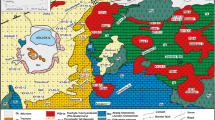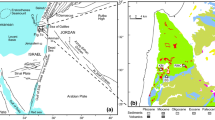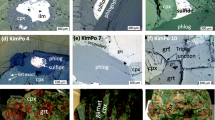Abstract
Felsic granulite xenoliths entrained in Miocene (~13 Ma) isotopically evolved, mantle-derived ultrapotassic volcanic (UPV) dykes in southern Tibet are refractory meta-granitoids with garnet and rutile in a near-anhydrous quartzo-feldspathic assemblage. High F–Ti (~4 wt.% TiO2 and ~3 wt.% F) phlogopite occurs as small inclusions in garnet, except for one sample where it occurs as flakes in a quartz-plagioclase-rich rock. High Si (~3.45) phengite is found as flakes in another xenolith sample. The refractory mineralogy suggests that the xenoliths underwent high-T and high-P metamorphism (800–850 °C, >15 kbar). Zircons show four main age groupings: 1.0–0.5 Ga, 50–45, 35–20, and 16–13 Ma. The oldest group is similar to common inherited zircons in the Gangdese belt, whereas the 50–45 Ma zircons match the crystallization age and juvenile character (εHf i +0.5 to +6.5) of Eocene Gangdese arc magmas. Together these two age groups indicate that a component of the xenolith was sourced from Gangdese arc rocks. The 35–20 Ma Miocene ages are derived from zircons with similar Hf–O isotopic composition as the Eocene Gangdese magmatic zircons. They also have similar steep REE curves, suggesting they grew in the absence of garnet. These zircons mark a period of early Miocene remelting of the Eocene Gangdese arc. By contrast, the youngest zircons (13.0 ± 4.9 Ma, MSWD = 1.3) are not zoned, have much lower HREE contents than the previous group, and flat HREE patterns. They also have distinctive high Th/U ratios, high zircon δ18O (+8.73–8.97 ‰) values, and extremely low εHf i (−12.7 to −9.4) values. Such evolved Hf–O isotopic compositions are similar to values of zircons from the UPV lavas that host the xenolith, and the flat REE pattern suggests that the 13 Ma zircons formed in equilibrium with garnet. Garnets from a strongly peraluminous meta-tonalite xenolith are weakly zoned or unzoned and fall into four groups, three of which are almandine-pyrope solid solutions and have low δ18O (+6 to 7.5 ‰), intermediate (δ18O +8.5 to 9.0 ‰), and high δ18O (+11.0 to 12.0 ‰). The fourth is almost pure andradite with δ18O 10–12 ‰. Both the low and intermediate δ18O groups show significant variation in Fe content, whereas the two high δ18O groups are compositionally homogeneous. We interpret these features to indicate that the low and intermediate δ18O group garnets grew in separate fractionating magmas that were brought together through magma mixing, whereas the high δ18O groups formed under high-grade metamorphic conditions accompanied by metasomatic exchange. The garnets record complex, open-system magmatic and metamorphic processes in a single rock. Based on these features, we consider that ultrapotassic magmas interacted with juvenile 35–20 Ma crust after they intruded in the deep crust (>50 km) at ~13 Ma to form hybridized Miocene granitoid magmas, leaving a refractory residue. The ~13 Ma zircons retain the original, evolved isotopic character of the ultrapotassic magmas, and the garnets record successive stages of the melting and mixing process, along with subsequent high-grade metamorphism followed by low-temperature alteration and brecciation during entrainment and ascent in a late UPV dyke. This is an excellent example of in situ crust–mantle hybridization in the deep Tibetan crust.














Similar content being viewed by others
References
Ali JR, Aitchison JC (2005) Greater India. Earth Sci Rev 72:169–188
Bartholomé P (1960) Genesis of the Gore Mountain garnet deposit New York. Econ Geol 55:255–277
Black LP, Kamo SL, Allen CM, Davis D, Aleinikoff JN, Valley JW, Mundil R, Campbell IH, Korsch RJ, Williams IS, Foudoulis C (2004) Improved 206Pb/238U microprobe geochronology by the monitoring of a trace-element-related matrix effect; SHRIMP ID–TIMS ELA–ICP–MS and oxygen isotope documentation for a series of zircon standards. Chem Geol 205:115–140
Chan GHN, Waters DJ, Searle MP, Aitchison JC, Horstwood MSA, Crowley Q, Lo CH, Chan JSL (2009) Probing the basement of southern Tibet: evidence from crustal xenoliths entrained in a Miocene ultrapotassic dyke. J Geol Soc Lond 166:45–52
Chung SL, Chu MF, Zhang YQ, Xie YW, Lo CH, Lee TY, Lan CY, Li XH, Zhang Q, Wang YZ (2005) Tibetan tectonic evolution inferred from spatial and temporal variations in post-collisional magmatism. Earth Sci Rev 68:173–196
Ding L, Kapp P, Zhong D, Deng W (2003) Cenozoic volcanism in Tibet: evidence for a transition from oceanic to continental subduction. J Petrol 44:1833–1865
Ding L, Kapp P, Yue YH, Lai QZ (2007) Postcollisional calc-alkaline lavas and xenoliths from the southern Qiangtang terrane central Tibet. Earth Planet Sci Lett 254:28–38
Gao YF, Hou ZQ, Kamber B, Wei RH, Meng XJ, Zhao RS (2007) Adakite-like porphyries from the southern Tibetan continental collision zones: evidence for slab melt metasomatism. Contrib Miner Petrol 153:105–120
Gromet LP, Silver LT (1983) Rare earth element distributions among minerals in a granodiorite and their petrogenetic implications. Geochim Cosmochim Acta 47:925–939
Guo ZF, Wilson M (2012) The Himalayan leucogranites: constraints on the nature of their crustal source region and geodynamic setting. Gondwana Res 22:360–376
Guo ZF, Wilson M, Zhang ML, Cheng ZH, Zhang LH (2015) Post-collisional ultrapotassic mafic magmatism in South Tibet: products of partial melting of pyroxenite in the lithospheric mantle wedge induced by roll-back and delamination of the subducted Indian continental lithosphere slab. J Petrol 56:1365–1406
Hacker BR, Gnos E, Ratschbacher L, Grove M, McWilliams M, Sobolev S, Jiang W, Wu ZH (2000) Hot and dry deep crustal xenoliths from Tibet. Science 287:2463–2466
Hodges KV, Crowley PD (1985) Error estimation and empirical geothermobarometry for politic systems. Am Miner 70:702–709
Hodges K, Spear FS (1982) Geothermometry geobarometry and the Al2SiO5 triple point at MT Moosilauke New Hampshire. Am Miner 67:1118–1134
Hoskin WP, Black LP (2000) Metamorphic zircon formation by solid-state recrystallization of protolith igneous zircon. J Metamorph Geol 18:423–439
Hou ZQ, Gao YF, Qu XM, Rui ZY, Mo XX (2004) Origin of adakitic intrusives generated during mid-Miocene east-west extension in southern Tibet. Earth Planet Sci Lett 220:139–155
Hou ZQ, Zhang HR, Pan XF, Yang ZM (2011) Porphyry Cu (-Mo-Au) deposits related to melting of thickened mafic lower crust: Examples from the eastern Tethyan metallogenic domain. Ore Geol Rev 39:21–45
Hou ZQ, Duan LF, Lu YJ, Zheng YC, Zhu DC, Yang ZM, Yang ZS, Wang BD, Pei YR, Zhao ZD, McCuaig TC (2015) Lithospheric architecture of the Lhasa Terrane and its control on ore deposit in the Himalayan–Tibetan orogen. Econ Geol 110:1541–1575
Ikert RB, Stern RA (2013) Matrix corrections and error analysis in high-precision SIMS 18O/16O measurements of Ca–Mg–Fe garnet. Geostand Geoanal Res 37:429–448
Ji WQ, Wu FY, Chung SL, Li JX, Liu CZ (2009) Zircon U–Pb geochronology and Hf isotopic constraints on petrogenesis of the Gangdese batholith southern Tibet. Chem Geol 262:229–245
Ji WQ, Wu FY, Liu CZ, Chung SL (2012) Early Eocene crustal thickening in southern Tibet: new age and geochemical constraints from the Gangdese batholith. J Asian Earth Sci 53:82–95
Lepage LD (2003) ILMAT: an Excel worksheet for ilmenite-magnetite geothermometry and geobarometry. Comput Geosci 29:673–678
Liu CZ, Wu FY, Chung SL, Zhao ZD (2011) Fragments of hot and metasomatized mantle lithosphere in middle miocene ultrapotassic lavas southern Tibet. Geology 39:923–926
Liu D, Zhao ZD, Zhu DC, Niu YL, Harrison TM (2014) Zircon xenocrysts in Tibetan ultrapotassic magmas: imaging the deep crust through time. Geology 42:43–46
Massonne HJ (2016) Hydration of the lithospheric mantle by the descending plate in a continent-continent collisional setting and its geodynamic consequences. J Geodyn 96:50–61
Massonne HJ, Schreyer W (1987) Phengite geobarometry based on the limiting assemblage with K-feldspar phlogopite and quartz. Contrib Miner Petrol 96:212–224
McDowell SM, Miller CF, Mundil R, Ferguson CA, Wooden JL (2014) Zircon evidence for a ~200 k.y. supereruption-related thermal flare-up in the Miocene southern Black Mountains, western Arizona, USA. Contrib Mineral Petrol 168:1031
Meng J, Wang C, Zhao X, Coe R, Li YL, Finn D (2012) India–Asia collision was at 24°N and 50 Ma: paleomagnetic proof from southern Asia. Sci Rep. doi:10.1038/srep00925
Miller C, Schuster R, Klotzli U, Frank W, Purtscheller F (1999) Post-collisional potassic and ultrapotassic magmatism in SW Tibet: geochemical Sr–Nd–Pb–O isotopic constraints for mantle source characteristics and petrogenesis. J Petrol 40:1399–1424
Mo XX, Hou ZQ, Niu YL, Dong GC, Zhao ZD, Yang ZM (2007) Mantle contributions to crustal thickening during continental collision: evidence from Cenozoic igneous rocks in southern Tibet. Lithos 96:225–242
Reche J, Martinez FJ (1996) GPT: an Excel spreadsheet for thermobarometric calculations in metapelitic rocks. Comput Geosci 22:775–784
Replumaz A, Negredo AM, Villaseñor A, Guillot S (2010) Indian continental subduction and slab break-off during Tertiary collision. Terra Nova 22:290–296
Rubatto D (2002) Zircon trace element geochemistry: partitioning with garnet and the link between U–Pb ages and metamorphism. Chem Geol 184:123–138
Sisson TW, Ratajeski K, Hankins WB, Glazner AF (2005) Voluminous granitic magmas from common basaltic sources. Contrib Miner Petrol 148:635–661
Stern RA, Amelin Y (2003) Assessment of errors in SIMS zircon U–Pb geochronology using a natural zircon standard and NIST SRM 610 glass. Chem Geol 197:111–146
Turner S, Arnaud N, Liu J, Rogers N, Hawkesworth C, Harris N, Kelley S, van Calsteren P, Deng W (1996) Post-collision, shoshonitic volcanism on the Tibetan plateau: implications for convective thinning of the lithosphere and the source of ocean island basalts. J Petrol 37:45–71
van Hinsbergen DJJ, Lippert PC, Dupont-Nivet G, McQuarrie N, Doubrovine PV, Spakman W, Torsvik TH (2012) Greater India basin hypothesis and a two-stage Cenozoic collision between India and Asia. PNAS 20:7659–7664
Velde B (1967) Si+4 content of natural phengite. Contrib Miner Petrol 14:250–258
Wang SJ, Li SG, An SC, Hou ZH (2012) A granulite record of multistage metamorphism and REE behavior in the Dabie orogen: constraints from zircon and rock-forming minerals. Lithos 136:109–125
Wang R, Richards JP, Hou ZQ, Yang ZM, DuFrane SA (2014a) Increased magmatic water content—the key to Oligo-Miocene porphyry Cu–Mo ± Au formation in the eastern Gangdese belt Tibet. Econ Geol 109:1315–1339
Wang R, Richards JP, Hou ZQ, Yang ZM, Gou ZB, DuFrane SA (2014b) Increasing magmatic oxidation state from Paleocene to Miocene in the eastern Tibetan Gangdese belt: implication for collision-related porphyry Cu–Mo ± Au mineralization. Econ Geol 109:1943–1965
Wang R, Richards JP, Zhou LM, Hou ZQ, Stern RA, Creaser RA, Zhu JJ (2015a) the Role of Indian and Tibetan lithosphere in spatial distribution of Cenozoic magmatism and porphyry Cu–Mo ± Au deposits in the Gangdese belt southern Tibet. Earth Sci Rev 150:68–94
Wang R, Richards JP, Hou ZQ, An F, Creaser RA (2015b) Zircon U–Pb age and Sr–Nd–Hf–O isotope geochemistry of the Paleocene–Eocene igneous rocks in western Gangdese: evidence for the timing of Neo-Tethyan slab breakoff. Lithos 224–225:179–194
Watson EB, Harrison TM (2005) Zircon thermometer reveals minimum melting conditions on earliest Earth. Science 308:841–844
Wen DR, Chung SL, Song B, Iizuka Y, Yang HJ, Ji JQ, Liu DY, Gallet S (2008) Late Cretaceous Gangdese intrusions of adakite-like geochemical characteristics SE Tibet: petrogenesis and tectonic implications. Lithos 105:1–11
Wendlandt RF, Eggler DH (1980) The origins of potassic magmas: 2. Stability of phlogopite in natural spinel lherzolite and in the system KAlSiO4-MgO-SiO2-H2O-CO2 at high pressures and high temperatures. American J Sci 280:421–458
Williams HM (2000) Magmatic and tectonic evolution of Southern Tibet and the Himalaya. Ph.D. thesis, The Open University 329
Williams HM, Turner SP, Pearce JA, Kelley SP, Harris NBW (2004) Nature of the source regions for post-collisional potassic magmatism in southern and northern Tibet from geochemical variations and inverse trace element modeling. J Petrol 45:555–607
Yang ZM, Hou ZQ, White NC, Chang ZS, Li ZQ, Song YC (2009) Geology of the post-collisional porphyry copper-molybdenum deposit at Qulong, Tibet. Ore Geol Rev 36:133–159
Yin A, Harrison TM (2000) Geologic evolution of the Himalayan–Tibetan orogen. Annu Rev Earth Planet Sci 28:211–280
Ying LJ, Wang CS, Tang, JX, Wang DH, Qu WJ, Li C (2014) Re-Os systematics of sulfides (chalcopyrite, bornite, pyrite and pyrrhotite) from the Jima Cu-Mo deposit of Tibet, China. J Asian Earth Sci 79:497–506
Zhang K, Zhang Y, Li B, Zhong L (2007) Nd isotopes of siliciclastic rock from Tibet western China: constraints on provenance and pre-Cenozoic tectonic evolution. Earth Planet Sci Lett 256:604–616
Zhao ZD, Mo XX, Dilek Y, Niu YL, DePaolo DJ, Robinson P, Zhu DC, Sun CG, Dong GC, Zhou S, Luo ZH, Hou ZQ (2009) Geochemical and Sr–Nd–Pb–O isotopic compositions of the post-collisional ultrapotassic magmatism in SW Tibet: petrogenesis and implications for India-continental subduction beneath southern Tibet. Lithos 113:190–212
Zhao J, Yuan X, Liu H, Kumar P, Pei S, Kind R, Zhang Z, Teng J, Ding L, Gao X, Xu Q, Wang W (2010) The boundary between the Indian and Asian tectonic plates below Tibet. PNAS 107:11229–11233
Zhu DC, Mo XX, Niu YL, Zhao ZD, Wang LQ, Liu YS, Wu FY (2009) Geochemical investigation of early Cretaceous igneous rocks along an east–west traverse throughout the central Lhasa Terrane Tibet. Chem Geol 268:298–312
Zhu DC, Mo XX, Zhao ZD, Niu YL, Wang LQ, Chu QH, Pan GT, Xu JF, Zhou CY (2010) Presence of permian extension- and arc-type magmatism in southern Tibet: paleogeographic implications. GSA Bull 122:979–993
Zhu DC, Zhao ZD, Niu YL, Mo XX, Chung SL, Hou ZQ, Wang LQ, Wu FY (2011a) The Lhasa terrane: record of a microcontinent and its histories of drift and growth. Earth Planet Sci Lett 301:241–255
Zhu DC, Zhao ZD, Niu YL, Dilek Y, Mo XX (2011b) Lhasa terrane in southern Tibet came from Australia. Geology 39:727–737
Acknowledgments
This study was funded by CSIRO OCE postdoc three-year (2014–2017) project to Rui Wang, Australian Research Council DP110102543 to Roberto F. Weinberg and DP120104004 to William J. Collins, a Discovery Grant from the Natural Sciences and Engineering Research Council of Canada to Jeremy Richards, the China National Funds for Distinguished Scientists (No. 41302054) to Li-min Zhou, and IGCP/SIDA-600. Anna Oh is thanked for SIMS zircon sample preparation and dating, and Robert Creaser is thanked for whole-rock Sr–Nd isotopic analysis.
Author information
Authors and Affiliations
Corresponding author
Additional information
Communicated by Hans Keppler.
Electronic supplementary material
Below is the link to the electronic supplementary material.
Rights and permissions
About this article
Cite this article
Wang, R., Collins, W.J., Weinberg, R.F. et al. Xenoliths in ultrapotassic volcanic rocks in the Lhasa block: direct evidence for crust–mantle mixing and metamorphism in the deep crust. Contrib Mineral Petrol 171, 62 (2016). https://doi.org/10.1007/s00410-016-1272-6
Received:
Accepted:
Published:
DOI: https://doi.org/10.1007/s00410-016-1272-6




